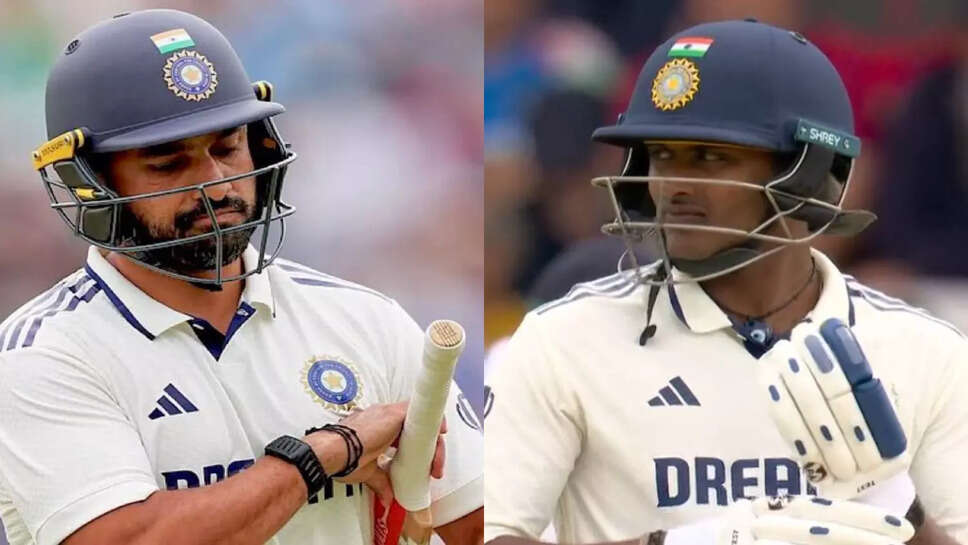Changing of the Guard? Sudharsan-Karun Switch Mirrors Dravid-Manjrekar 1996 Shift

The announcement of Sai Sudharsan as a probable inclusion in the Indian Test squad, seemingly at the expense of Karun Nair, has ignited conversations among cricket enthusiasts and historians. And rightly so — the development bears an uncanny resemblance to a moment etched in Indian cricketing lore: Rahul Dravid replacing Sanjay Manjrekar on the 1996 tour to England.
That pivotal shift, nearly three decades ago, marked the beginning of a new era in Indian cricket. Today, as the selectors look to inject fresh blood into the middle order, the decision surrounding Sudharsan and Nair suggests a similar inflection point — a symbolic passing of the torch.
Deja Vu in Selection Rooms
Much like Sanjay Manjrekar in 1996, Karun Nair finds himself on the periphery despite a respectable domestic record and a triple century in Test cricket — a feat only a handful of Indians have achieved. Yet, inconsistency, lack of backing, and a younger challenger peaking at the right time have pushed him to the sidelines.
Enter Sai Sudharsan: elegant, composed, and impressively consistent across formats. His domestic and IPL performances, marked by maturity and technical assurance, have made him a standout among the new generation. In Dravid-like fashion, he appears ready to step into the vacuum of India’s transitional middle order.
1996: The Manjrekar-Dravid Precedent
To fully understand the parallels, a revisit to the summer of 1996 is necessary. Sanjay Manjrekar, once considered the next great hope of Indian batting, was struggling to justify his place amidst rising competition. Despite his technical prowess and overseas experience, a string of modest scores made him expendable in a squad eager for rejuvenation.
Rahul Dravid, then a young and untested player from Karnataka, was given the nod. The venue was Lord’s — the challenge, monumental. Yet Dravid delivered a masterclass 95 on debut, forging a template for Indian batsmanship that would last for nearly two decades.
That decision marked more than just a selection — it was a pivot. It represented a shift in thinking, from experience to promise, from past laurels to future potential. Sai Sudharsan’s selection carries a similar weight.
The Rise of Sai Sudharsan
Sudharsan has not emerged out of nowhere. His rise has been steady, deliberate, and impressive. A strong performer for Tamil Nadu in domestic cricket, he made waves in the Indian Premier League with his temperament under pressure and ability to anchor innings — qualities that scream "red-ball potential."
His batting carries shades of a young Dravid — compact footwork, calm head, and an ability to accumulate without undue flashiness. While Sudharsan has mostly played white-ball cricket, those who’ve followed his red-ball game closely describe him as a natural fit for the longer format.
Selectors have evidently seen enough. The inclusion signals trust not just in ability, but in temperament — the X-factor that separates good from great.
Karun Nair: A Career of What-Ifs
The comparison to Manjrekar doesn’t just lie in their playing styles — both Karun and Manjrekar were victims of timing, team dynamics, and possibly conservative selection philosophies. Karun’s Test triple century in 2016 against England remains a towering highlight, yet his career since has been a perplexing trail of missed opportunities.
He was often benched, overlooked in favour of others, and failed to string a consistent run. Just like Manjrekar, whose classical style and orthodox technique were viewed as too slow or outdated in the changing landscape of cricket, Karun too found himself outpaced by more aggressive or dynamic peers.
If Sudharsan indeed takes Karun’s spot permanently, it will feel like déjà vu to older fans — a younger player taking over just as a seasoned pro begins to fade from the selectors' imagination.
Evolution of Indian Batting Philosophy
What also mirrors 1996 is the philosophy driving this potential shift. The Indian team then was transitioning from reliance on senior batters like Azharuddin and Sidhu to fresh blood like Ganguly, Dravid, and Tendulkar. Today, a similar change is afoot. With Virat Kohli aging, Cheteshwar Pujara out of favour, and Ajinkya Rahane inconsistent, a new batting order is being carved out.
Sai Sudharsan is not just a player — he’s a prototype of India’s next generation: agile, calm under pressure, capable across formats, and technically sound. Like Dravid, he is not necessarily a flamboyant T20 star, but someone who can bat for time, see off sessions, and anchor innings — the very essence of Test cricket.
Selectors and Timing: A Delicate Balance
Cricketing transitions often depend not just on form but timing. In 1996, it was the selectors' call to hand Dravid a cap that opened the doors to greatness. Today, in a hyper-competitive environment, such decisions are even more high-stakes.
Choosing Sai Sudharsan over Karun Nair signals that selectors are willing to look ahead. That they value potential, present form, and readiness over reputation. It’s a hard call, but history has often rewarded such boldness.
The Road Ahead for Sudharsan
If given the opportunity, Sudharsan will need to emulate not just Dravid’s technique, but his mentality. The debut will be intense. The scrutiny, overwhelming. The comparisons, inevitable. But much like Lord’s 1996, a breakthrough performance can redefine careers and eras.
He enters at a time when India is in the hunt for solidity in the middle order. A space that once belonged to Dravid and Pujara is now wide open. Should he seize it, Sai Sudharsan could very well be India’s next mainstay — a player to build around for the next decade.
For Karun Nair, Hope Lingers
It’s not the end of the road for Karun Nair — cricket has strange ways of offering second chances. Just as Manjrekar continued playing domestic cricket with distinction post-1996, Karun too has the skill and hunger to fight back. But for now, the spotlight has shifted.
And as Sai Sudharsan steps into the shoes of experience, much like a young Dravid once did, Indian cricket watchers can’t help but feel a wave of nostalgia — and perhaps, a sense of déjà vu.
Because sometimes, cricket doesn’t just repeat history. It rhymes.
